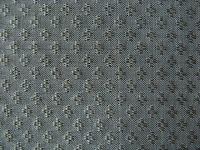 This group is one of many that has received OTOP recognition. OTOP -- One Tamboon, One Product -- is a program started many years ago by a previous government. It gives star ratings to products that range from foods to simple handicrafts to superb textiles, designating products considered outstanding in each district. The Pa Ao Weaving Group, which also refers to itself as Glum Satrii (Homemakers' Group), has received 4 and 5 star OTOP ratings in past years for its superlative weaving.
This group is one of many that has received OTOP recognition. OTOP -- One Tamboon, One Product -- is a program started many years ago by a previous government. It gives star ratings to products that range from foods to simple handicrafts to superb textiles, designating products considered outstanding in each district. The Pa Ao Weaving Group, which also refers to itself as Glum Satrii (Homemakers' Group), has received 4 and 5 star OTOP ratings in past years for its superlative weaving.On that first visit, we bought several naturally dyed silk scarves from the group's village shop. Unlike any designs we'd seen before, these scarves showcased mudmee designs (the tie-dyeing of the thread prior to weaving) with a seldom-seen contemporary flare.

We had hoped to meet this group again at last year's OTOP fair in Bangkok. Remarkably, we did find the group amongst the hundreds of stalls at last year's fair but they didn't have the scarves we were searching for and we were unable to describe them well enough to make an order.
Which brings this post to yesterday, when we set out on another rented motorbike in search of these unusual scarves. We arrived in the early afternoon to find 3 very helpful women at the Ban Pa Ao weaving shop but not the elusive scarves.
Rather than trying to persuade us to consider the conventionally dyed scarves that some of their members continue to produce, the staff took the opportunity to bring out some extraordinary, handwoven, naturally dyed silk fabrics that are available by the metre. We couldn't resist buying 5 particularly beautiful pieces (3 of which are shown below). These will be available upon our return home to Canada in April.
 This piece has an amazing sheen with small vertical stripes. It's dyed with indigo and coconut husks soaked until the colour leaches into the water.
This piece has an amazing sheen with small vertical stripes. It's dyed with indigo and coconut husks soaked until the colour leaches into the water. This piece is woven in a delicate flower pattern called dok pikhuun. It has a soft gray colour that is created with a dried fruit that is then boiled, pounded and soaked until the dye bath is ready.
This piece is woven in a delicate flower pattern called dok pikhuun. It has a soft gray colour that is created with a dried fruit that is then boiled, pounded and soaked until the dye bath is ready. This piece has a delicate shimmer obtained with jackfruit wood, another wood called prahot and coconut husk. The colours are made stronger by the addition of sai bua in which the silk yarns are soaked for a few days. It uses a mudmee design in the umber and pale green stripes, twisted threads and a white weft (cross-wise threads), which gives the shimmer.
This piece has a delicate shimmer obtained with jackfruit wood, another wood called prahot and coconut husk. The colours are made stronger by the addition of sai bua in which the silk yarns are soaked for a few days. It uses a mudmee design in the umber and pale green stripes, twisted threads and a white weft (cross-wise threads), which gives the shimmer.Because we follow a fair trade model, we wanted to learn not just about these production details but also about the group which has mastered them: the group with whom we are working to establish a relationship. Here's some of what we've learned:
- The group was started 22 years ago.
- Ten years ago, it had 75 members and has since grown to 108, all local Pa Ao village residents.
- Group members use chemical dyes and natural dyes, particularly local materials like kram (indigo), lac (which produces lovely pinks and reds) and magrua (ebony black). They have since learned to dye with other natural materials, such as coconut and jackfruit wood.
- All dye materials are gathered locally.


At the group's shop and weaving centre, we were shown samples of dye materials and silk yarns that had been dyed with them. Here you see Alleson and Nan, a group member, looking at samples of natural dye baths prepared by local students.
Our visit was not quite what we had expected but this is always part of the fun. Thanks to Alleson's ability to speak Thai, we learned more about the group and how they make such delicate colours using natural dyes from their local environment. Thanks also to her ability to read Thai (albeit slowly), we also learned the Thai names of several dye materials new to us.
Each new word helps us communicate better with the Thai weavers from whom we buy textiles. (My Thai is still rudimentary but my ability to understand and speak grows slowly, but daily, as we travel.) Being able to communicate, even a little, with the weavers enriches our understanding of their traditions and practices. It also allows us to bring you more stories about the creation of these incredible fibre arts.
Nok Noi (aka Ellen)
